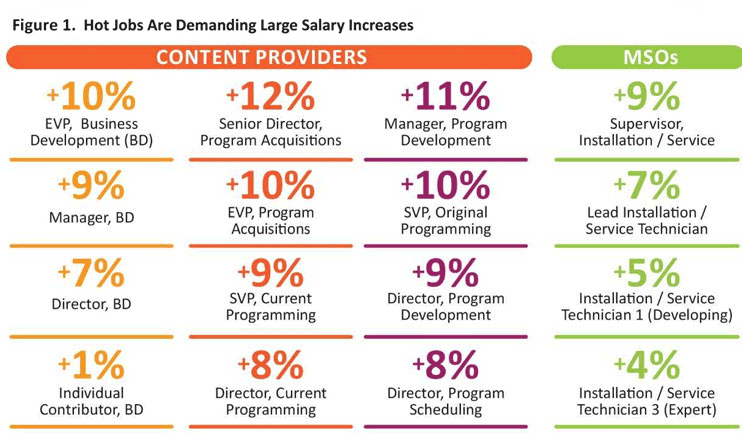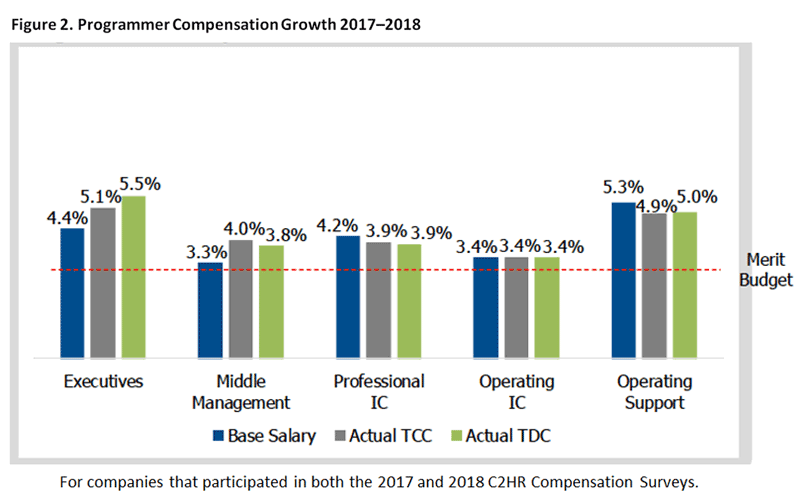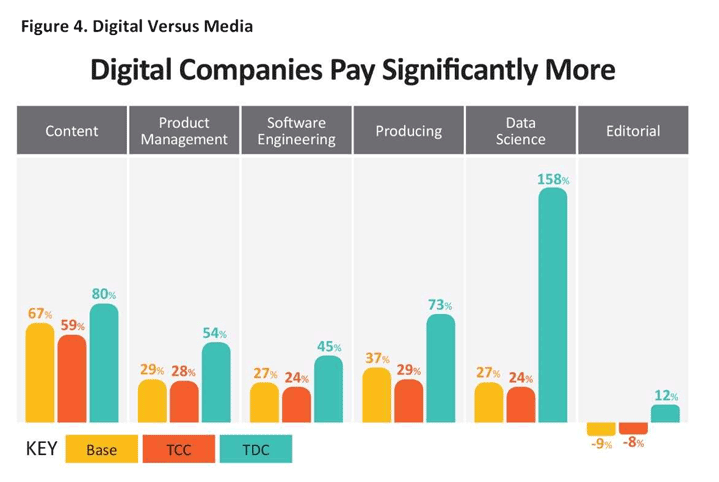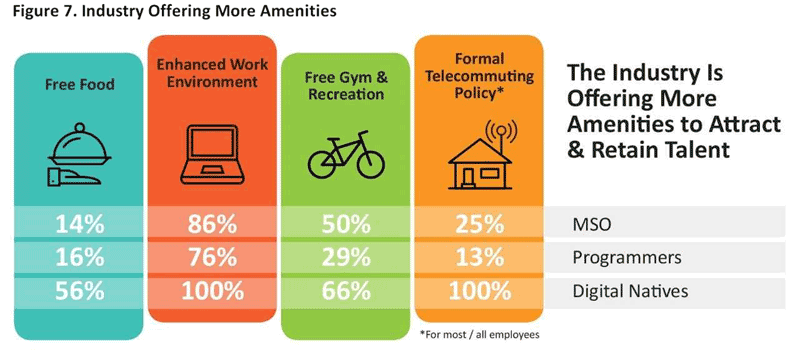|

Industry Salaries
Skyrocket for High Demand Jobs
Since 2002, our association has annually
conducted an industry-specific survey to provide compensation
benchmarks for MSOs/operators and programmers. In 2018,
the 59 participants represented approximately 205,000 employees
and provided data for 869 job positions ranging from entry
level to executives.
The ongoing push to customize
the viewers’ experience and the aggressive spend for
content development by digital players is dramatically driving
compensation for business development, programming and installation
jobs in the cable and media industry. The recently released
surveys also revealed that programmer compensation grew
robustly for executives and operating support personnel,
while management gained larger salary increases at multiple
system operators (MSOs).
“C2HR's Annual Compensation
Surveys uncover market pressures and valuable metrics that
our members use to ensure competitive compensation strategies,”
said Pamela Williams, CAE, C2HR’s executive director.
“These are the most
comprehensive surveys of our industry available. Without
them, we would be somewhat hamstrung for data unique to
our industry or to correlate with data outside our industry,”
said Robert Scott, director of compensation for Cox
Communications.
The 2018 surveys uncovered
the fiercely competitive market for specific “hot”
jobs, propelled by continued pressure from digital media.
In 2017, Netflix was the fifth highest investor in content
development, spending $6.3 billion on non-sports programming
with Amazon (No. 7) following at $4.5 billion.1
“That’s
a huge amount of spend invading,” said Hali Croner,
president and chief executive officer (CEO) of The Croner
Company, the research and compensation consulting firm that
conducted the surveys for C2HR. “In the programming
space, salaries are going up to compete with technology
and digital companies that are premium payers.”
1
At programmers, the largest base
salary increases occurred for positions in business development
and programming (see Figure 1). For example,
base salary for executive vice president (EVP) of business
development (BD) soared by 10% over 2017, while BD managers,
directors and individual contributors (ICs) saw gains of
9%, 7% and 7% respectively. These individuals are responsible
for securing new content partnerships, co-branding agreements
and user acquisitions (i.e., “more eyeballs watching
your content”).

“Business development
is seeing a premium because of the need for new revenue
streams and strong people in those areas,” said Croner.
“Traditional TV revenue is still amazing, but it’s
not growing the way that digital is.”
Lisa Kaye, president and
CEO of greenlightjobs, and co-chair of C2HR’s Compensation
Surveys, added that programmers are looking for ways to
leverage YouTube streaming, podcasts and other digital media
platforms. “They need to be more creative about how
they are producing content to get it out to people quicker,
faster and easier so they can monetize it. That’s
pushing the business model, and that is why business development
jobs are hot,” she said.
“Historically, cable
programmers were heavy on acquisition from independents.
A lot of that is moving in house again,” she added.
“They want to be able to churn out and own the content
so that they can have as many distribution platforms as
possible.”
Base salaries for numerous
programming jobs also increased dramatically, climbing by
8% for director of current programming and director of program
scheduling while skyrocketing by 12% for senior director
of program acquisitions.
“If Netflix and
Amazon are making a huge spend in programming and they are
picking off your top people, then programming talent becomes
scarce. Those jobs become hot,” said Croner. Such
scarcity spurs compensation.
MSOs also responded to competitive
pressures, such as Charter’s and Amazon’s move
to increase their minimum wage to $15 an hour and a national
unemployment rate that’s hovering at 3.7%, a near
50-year low. Among MSOs, installation jobs achieved the
largest raises. Base salaries climbed by 4% for installation/service
technician Level 3 to 9% for supervisor of installation/service
(see Figure 1).
“These individuals
— who go into the home — are the most important
representatives of the company,” said Croner. “Companies
are doing what they can through compensation, training and
enhancing the employee experience to make sure they keep
them and reward their strong performers.”
Scott concurred. “Our
Universal Home Tech is uniquely situated to address any
concerns of the customer and to recommend other
products or services in which the customer may be interested,
such as home security, faster Internet speed if gaming stations
are apparent or if multiple devices (door bells, tablets,
etc.) can be observed,” he said.
“This last face-to-face
with the customer requires skills beyond just technical
skills — discernment, respect, soft selling, addressing
concerns and advocating the features, advantages and benefits
of the additional services being discussed, which may be
a reason for the increase in pay, as well as the proliferation
of others getting into the installation space,” continued
Scott.
Additionally, the skills,
abilities and talent of those in technology, sales, customer
service, network readiness, network operations and a host
of other functions are “key to delivering content
anywhere, anytime whenever the customer expresses the want,
need, or desire,” he added.
Increases for hot jobs occurred against
the backdrop of a 3% salary merit budget for the industry,
slightly higher than the 2.9% national average. Programmers
reported total compensation exceeding the budget in all
employment categories. Programming executives garnered the
greatest gains, achieving a 5.5% increase in total direct
compensation (TDC), which includes all three elements of
compensation — base salary, bonus and stock incentives
(see Figure 2). Operating support personnel,
such as technical directors and camera operators, accrued
5.0% TDC, while operating ICs earned 3.4% TDC.

At MSOs, management, which
includes supervisor through EVP, achieved the greatest gains:
5.1% base salary increase and 4.6% TDC. MSO salaried employees
fell below the merit budget at 1.8% base salary increase
and 2.1% TDC raise (see Figure 3).

These increases indicate
a responsivity to market conditions. “Companies are
paying attention to people who are long-term contributors
and taking care of them,” explained Croner.
Geography continues to
impact salaries for MSO installers and service technicians.
Base salaries were higher in the West by 8% (lead) to 16%
(expert) and East by 3% (developing) to 12% (expert), while
MSOs in the Southwest, Mountain, Midwest and South reported
lower salaries for installers and techs.
To ensure continued relevancy of
C2HR’s Compensation Surveys, each year participants
meet to hone job families and position titles for data collection.
The 2018 surveys collected data on 337 MSO positions and
532 programmer positions, an increase over last year. The
programmer survey also continued to collect international
salary data.
MSO participants added
two new job families and 19 new positions to the 2018 survey.
Many of these support today’s reality of content anywhere,
anytime; new technology-dependent service launches; and
entry into new sales channels. New MSO job families include
wireless engineering and store retail sales. New positions
include: associate wireless engineer to VP of wireless engineering,
manager of home security installation/ service, program
acquisition analyst/coordinator, manager of store retail
sales, supervisor of master control and manager/director
of workforce and traffic management.
“Home security
and business/commercial security will continue to be important;
commercial revenue is critical to future growth,”
said Cox’s Robert Scott. “High-speed Internet
is the lifeblood for everyone with a digital appliance,
phone, tablet, refrigerator or rice cooker....”
Programmers and broadcasters
added six new job families and 47 new positions. These jobs
reflect the critical need for data to support over-the-top
(OTT) content delivery, marketing to OTT viewers and creative
advertising sales strategies. Job families included: styling,
digital production technology, effects artists, business
intelligence engineering, advertising solutions, and extract
transform and load developing (data management). New positions
include: manager to VP of business intelligence, associate
marketing strategy IC to SVP of marketing strategy, senior
photographer to VP of photography, stylist/senior stylist,
manager/director of media operations, VP library and digital
assets, effects artist and manager/director of motion graphics
design.
Despite robust compensation increases
at programmers surveyed, digital natives continue to pay
more than traditional media companies in all key job families
except for editorial (see Figure 4).

“Even though programmers
are making really strong shifts, they can’t match
what strong digital payers will pay,” said Croner.
According to the Croner
Company’s 2018 Digital Content and Technology Survey,
TDC at digital and technology companies ranges from 45%
more for software engineering, to 80% more for content talent,
to an astounding 158% more for data science jobs.
“Digital companies
live off data science. They will find and keep those people
with big packages,” Croner added.
The industry continued its broad-based
support for short-term incentives or bonuses. In 2018, 93%
of MSOs offered bonuses, as did 89% of programmers. Eligibility
reached deep into the organizations, as 77% of MSOs and
63% of programmers offered bonuses to employees below managers
(See Figure 5).


Once again, long-term
incentives (LTIs) such as shares, stock options and long-term
cash remained largely limited to management (See Figure
6). At MSOs, 93% of participants offered LTIs,
with 100% of directors, VPs and executives receiving incentives.
Among programmers, 76%
of participants offered LTIs in 2018, although penetration
was less consistent than at MSOs, as 100% of executives
received LTIs, compared to 83% of VPs and 47% of directors.
This year, 8% of MSOs and 10% of programmers extended LTI
eligibility to employees below managers. Cable employers
continued to primarily offer full-value shares rather than
options or cash.
Four years ago, C2HR, recognizing
the expanded notion of compensation at digital companies,
began collecting data on amenities. In 2018, the industry
offered more perks to compete with digital. For the first
time, 14% of MSOs reported offering free food as did 16%
of programmers, compared with 56% of digital natives (see
Figure 7).
Enhanced work environments
continued to be popular with survey respondents, as 86%
of MSOs and 76% of programmers supported them. Gym memberships
also increased to 50% for MSOs and 29% at programmers (see
Figure 7).

“Health and fitness
are tops on the list of what employees are seeking after
a stimulating and challenging work environment,” said
Cox’s Scott. “While free or highly discounted
food was a staple of the earlier technology companies, emphasis
on how to remain fit, such as onsite workout facilities,
appear to be of greater importance today.”
Telecommuting remains
a complex issue for the industry, and mostly offered on
a case-by-case basis. Although 100% of digital natives provide
a formal telecommuting policy that applies to most or all
employees, only 25% of MSOs and 13% of programmers had such
policies.
While telecommuting can
improve productivity in congested regions, it may be difficult
to implement when serving customers due to compliance issues,
or when collaborating on content development, Croner noted.
“I’m not sure the business model supports telecommuting
as much it does for programing code.”
The pressure to deliver new content
anywhere, anytime will not soon cease. “The playing
field is increasingly competitive, and that will continue
– aggressively,” said Lisa Kaye. The industry
must, therefore, think creatively about compensation packages.
“Be prepared, flexible
and nimble,” advised Scott. “Read all you can
about new businesses, opportunities or threats in your local
labor markets.” For example, he noted that Amazon
opening a distribution center in your area will impact numerous
open jobs at all levels, while a new technology center will
severely impact the ability to attract and retain highly
competent technology jobs. “Being forewarned is being
forearmed,” he said.
Kaye advised: “Offering
accelerated learning and growth opportunities, flexible
working arrangements, greater equity stake and interests
and allowing employees to ‘design’ their own
compensation structures will give rise to greater attraction
and retention of star employees.”
She also suggested that
that the cable industry embrace employee-directed compensation
practices offered by digital companies, where employees
decide for themselves how their compensation mix is divided
between base, bonus and incentives.
“That’s a
very, very different philosophy from how traditional media
and entertainment businesses have operated,” Kaye
said. “Not only are digital companies paying more,
but they are changing how people get paid.”
She urged the industry
to be creative. “Money doesn’t have to be tied
to annual performance or grant, and it doesn’t have
to be cash.” Donations to charity, funds for continuing
education and spot bonuses are viable. “Give employees
the flexibility to feel like they have some say in how they
are rewarded and compensated,” Kaye added.

C2HR’s 2018 Compensation Surveys
included 59 participants. Companies included 14 MSOs and
45 programmers (see participant lists below). New participants
included: ADT, BBC Studios America Inc., Fanduel Group (TVG
Network), Game Show Network LLC and Google LLC (Google Fiber).
The survey results are
industry-specific, providing an in-depth analysis of pay
practices for approximately 205,000 incumbents, including
both exempt and nonexempt positions ranging from technicians
to top executives. The participants submitted data reflecting
2018 budgets, base compensation figures, amenities and benefits.
ADT
Altice USA, Inc.
Armstrong
AT&T
Cable One, Inc.
Charter Communications, Inc.
Comcast Cable Communications, Inc.
Cox Communications, Inc.
Google LLC
Mediacom Communications Corporation
RCN Telecom Services, LLC
TDS Broadband Service LLC
Verizon Communications Inc.
WOW! Internet, Cable & Phone
Altice USA, Inc.
Amazon.com Services, Inc.
AMC Networks Inc.
AT&T
BBC Studios Americas, Inc.
Blizzard Entertainment, Inc.
CBS Corporation - CBS Television
CBS Corporation - Showtime Networks Inc.
Charter Communications, Inc.
Crown Media Holdings, Inc.
Discovery Communications, Inc.
Disney ABC Television Group - Disney ABC Television
Disney ABC Television Group - Disney ABC Cable Networks
Group
ESPN, Inc.
Fanduel Group (formerly Betfair)
Fox Networks Group, Inc. - Fox Broadcasting Company
Fox Networks Group, Inc. - Fox Cable Networks Group
Fox News Network, LLC
Fuse Media
Game Show Network, LLC
Home Box Office, Inc.
Howard Hughes Medical Institute
Hulu, LLC
INSP, LLC
ION Media Networks, Inc.
Jet Propulsion Laboratory
Madison Square Garden
MLB Network, LLC
National Basketball Association
National Football League
NBCUniversal
NBCUniversal - NBCUniversal Cable Networks, Comcast Programming
Public Broadcasting Service
QVC, Inc.
Red Bull Media House North America, Inc.
Sony Pictures Entertainment
Starz Entertainment, LLC
The E.W. Scripps Company
Turner
Univision Communications Inc.
VEVO LLC
Viacom Media Networks
Warner Bros. Entertainment Inc. - The CW Television Network
Warner Bros. Entertainment Inc. - WBTV
World Wrestling Entertainment, Inc.
|